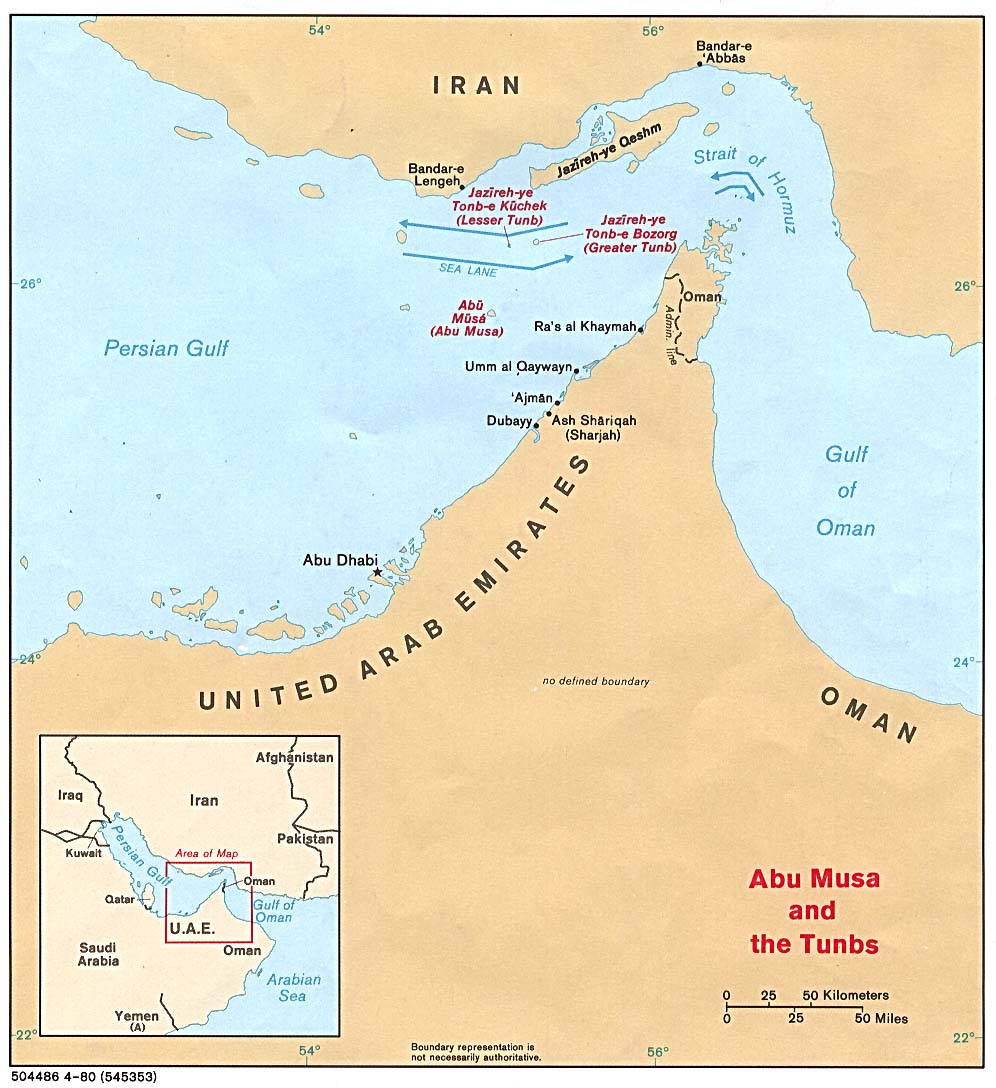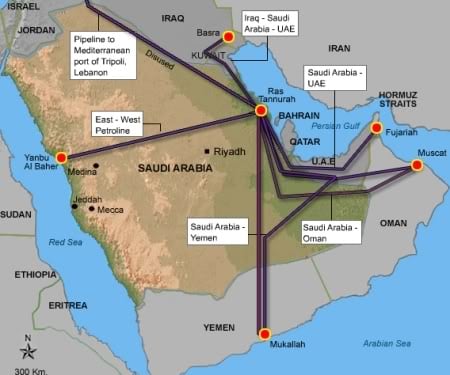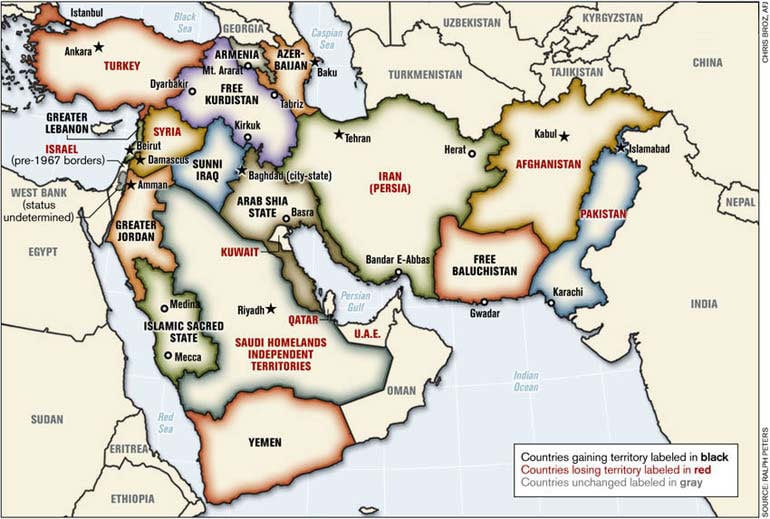Could the U.S. Navy be defeated by Iran in the Persian Gulf?
by Mahdi D. Nazemroaya
Global Research
January 10, 2012
After years of U.S. threats, Iran is taking steps which suggest that is both willing and capable of closing the Strait of Hormuz. On December 24, 2011 Iran started its Velayat-90 naval drills in and around the Strait of Hormuz and extending from the Persian Gulf and Gulf of Oman (Oman Sea) to the Gulf of Aden and the Arabian Sea.
Since the conduct of these drills, there has been a growing war of words between Washington and Tehran. Nothing the Obama Administration or the Pentagon have done or said so far, however, has deterred Tehran from continuing its naval drills.
The Geo-Political Nature of the Strait of Hormuz
Besides the fact that it is a vital transit point for global energy resources and a strategic chokepoint, two additional issues should be addressed in regards to the Strait of Hormuz and its relationship to Iran. The first concerns the geography of the Strait of Hormuz. The second pertains to the role of Iran in co-managing the strategic strait in accordance with international law and its sovereign national rights.
The maritime traffic that goes through the Strait of Hormuz has always been in contact with Iranian naval forces, which are predominantly composed of the Iranian Regular Force Navy and the Iranian Revolutionary Guard Navy. In fact, Iranian naval forces monitor and police the Strait of Hormuz along with the Sultanate of Oman via the Omani enclave of Musandam. More importantly, to transit through the Strait of Hormuz all maritime traffic, including the U.S. Navy, must sail through Iranian territorial waters. Almost all entrances into the Persian Gulf are made through Iranian waters and most exits are through Omani waters.
Iran allows foreign ships to use its territorial waters in good faith and on the basis of Part III of the United Nations Convention of the Law of the Sea’s maritime transit passage provisions that stipulate that vessels are free to sail through the Strait of Hormuz and similar bodies of water on the basis of speedy and continuous navigation between an open port and the high seas. Although Tehran in custom follows the navigation practices of the Law of the Sea, Tehran is not legally bound by them. Like Washington, Tehran signed this international treaty, but never ratified it.

American-Iranian Tensions in the Persian Gulf
In recent developments, the Iranian Majlis (Parliament) is re’evaluating the use of Iranian waters at the Strait of Hormuz by foreign vessels.
Legislation is being proposed to block any foreign warships from being able to use Iranian territorial waters to navigate through the Strait of Hormuz without Iranian permission; the Iranian Parliament’s National Security and Foreign Policy Committee is currently studying legislation which would establish an official Iranian posture. The latter would hinge upon Iranian strategic interests and national security. [1]
On December 30, 2011, the U.S.S. John C. Stennis carrier passed through the area where Iran was conducting its naval drills. The Commander of the Iranian Regular Forces, Major-General Ataollah Salehi, advised the U.S.S. John C. Stennis and other U.S. Navy vessels not to return to the Persian Gulf while Iran was doing its drills, saying that Iran is not in the habit of repeating a warning twice. [2] Shortly after the stern Iranian warning to Washington, the Pentagon’s press secretary responded by making a statement saying: “No one in this government seeks confrontation [with Iran] over the Strait of Hormuz. It’s important to lower the temperature.” [3]
In an actual scenario of military conflict with Iran, it is very likely that U.S. aircraft carriers would actually operate from outside of the Persian Gulf and from the southern Gulf of Oman and the Arabian Sea. Unless the missile systems that Washington is developing in the petro-sheikhdoms of the southern Persian Gulf are operational, the deployment of large U.S. warships in the Persian Gulf would be unlikely. The reasons for this are tied to geographic realities and the defensive capabilities of Iran.

Geography is against the Pentagon: U.S. Naval Strength has limits in the Persian Gulf
U.S. naval strength, which includes the U.S. Navy and the U.S. Coast Guard, has primacy over all the other navies and maritime forces in the world. Its deep sea or oceanic capabilities are unparalleled and unmatched by any other naval power. Primacy does not mean invincibility. U.S. naval forces in the Strait of Hormuz and the Persian Gulf are nonetheless vulnerable.
Despite its might and shear strength, geography literally works against U.S. naval power in the Strait of Hormuz and the Persian Gulf. The relative narrowness of the Persian Gulf makes it like a channel, at least in a strategic and military context. Figuratively speaking, the aircraft carriers and warships of the U.S. are confined to narrow waters or are closed in within the coastal waters of the Persian Gulf. [See map above]
This is where the Iranian military’s advanced missile capabilities come into play. The Iranian missile and torpedo arsenal would make short work of U.S. naval assets in the waters of the Persian Gulf where U.S. vessels are constricted. This is why the U.S. has been busily erecting a missile shield system in the Persian Gulf amongst the Gulf Cooperation Council (GCC) countries in the last few years.
Even the small Iranian patrol boats in the Persian Gulf, which appear pitiable and insignificant against a U.S. aircraft carrier or destroyer, threaten U.S. warships. Looks can be deceiving; these Iranian patrol boats can easily launch a barrage of missiles that could significantly damage and effectively sink large U.S. warships. Iranian small patrol boats are also hardly detectable and hard to target.
Iranian forces could also attack U.S. naval capabilities merely by launching missile attacks from the Iranian mainland on the northern shores of the Persian Gulf. Even in 2008 the Washington Institute for Near East Policy acknowledged the threat from Iran’s mobile coastal missile batteries, anti-ship missiles, and missile-armed small ships. [4] Other Iranian naval assets like aerial drones, hovercraft, mines, diver teams, and mini-submarines could also be used in asymmetrical naval warfare against the U.S. Fifth Fleet.
Even the Pentagon’s own war simulations have shown that a war in the Persian Gulf with Iran would spell disaster for the United States and its military. One key example is the Millennium Challenge 2002 (MC02) war game in the Persian Gulf, which was conducted from July 24, 2002 to August 15, 2002 and took almost two years to prepare. This mammoth drill was amongst the largest and most expensive war games ever held by the Pentagon. Millennium Challenge 2002 was held shortly after the Pentagon had decided that it would continue the momentum of the war in Afghanistan by targeting Iraq, Somalia, Sudan, Libya, Lebanon, Syria, and finishing off with the big prize of Iran in a broad military campaign to ensure U.S. primacy in the new millennium.
After Millennium Challenge 2002 was finished, the war game was “officially” presented as a simulation of a war against Iraq under the rule of President Saddam Hussein, but in actuality these war games pertained to Iran.[5] The U.S. had already made assessments for the upcoming Anglo-American invasion of Iraq. Moreover, Iraq had no naval capabilities that would merit such large-scale use of the U.S. Navy.
Millennium Challenge 2002 was conducted to simulate a war with Iran, which was codenamed “Red” and referred to an unknown Middle Eastern rogue enemy state in the Persian Gulf. Other than Iran, no other country could meet the perimeters and characteristics of “Red” and its military forces, from the patrol boats to the motorcycle units. The war simulation took place because Washington was planning on attacking Iran soon after invading Iraq in 2003.
The scenario in the 2002 war game started with the U.S., codenamed “Blue,” giving Iran a one-day ultimatum to surrender in the year 2007. The war game’s date of 2007 would chronologically correspond to U.S. plans to attack Iran after the Israeli attack on Lebanon in 2006, which was to extend, according to military plans, into a broader war against Syria. The war against Lebanon, however, did not go as planned and the U.S. and Israel realized that if Hezbollah could challenge them in Lebanon then an expanded war with Syria and Iran would be a disaster.
In Millennium Challenge 2002’s war scenario, Iran would react to U.S. aggression by launching a massive barrage of missiles that would overwhelm the U.S. and destroy sixteen U.S. naval vessels – an aircraft carrier, ten cruisers, and five amphibious ships. It is estimated that if this had happened in real war theatre context, more than 20,000 U.S. servicemen would have been killed in the first day following the attack. [6]
Next, Iran would send its small patrol boats – the ones that look insignificant in comparison to the U.S.S. John C. Stennis and other large U.S. warships – to overwhelm the remainder of the Pentagon’s naval forces in the Persian Gulf, which would result in the damaging and sinking of most of the U.S. Fifth Fleet and the defeat of the United States. After the U.S. defeat, the war games were started over again, but “Red” (Iran) had to operate under the assumption of handicaps and shortcomings, so that U.S. forces would be allowed to emerge victorious from the drill. [7] This outcome of the war games obviated the fact that the U.S. would have been overwhelmed in the context of a real conventional war with Iran in the Persian Gulf.
Hence, the formidable naval power of Washington is handicapped both by geography as well as Iranian military capabilities when it comes to fighting in the Persian Gulf or even in much of the Gulf of Oman. Without open waters, like in the Indian Ocean or the Pacific Ocean, the U.S. will have to fight under significantly reduced response times and, more importantly, will not be able to fight from a stand-off (militarily safe) distance. Thus, entire tool boxes of U.S. naval defensive systems, which were designed for combat in open waters using stand-off ranges, are rendered unpractical in the Persian Gulf.
Making the Strait of Hormuz Redundant to Weaken Iran?
The entire world knows the importance of the Strait of Hormuz and Washington and its allies are very well aware that the Iranians can militarily close it for a significant period of time. This is why the U.S. has been working with the GCC countries – Saudi Arabia, Qatar, Bahrain, Kuwait, Oman, and the U.A.E. – to re-route their oil through pipelines bypassing the Strait of Hormuz and channelling GCC oil directly to the Indian Ocean, Red Sea, or Mediterranean Sea. Washington has also been pushing Iraq to seek alternative routes in talks with Turkey, Jordan, and Saudi Arabia.
Both Israel and Turkey have also been very interested in this strategic project. Ankara has had discussions with Qatar about setting up an oil terminal that would reach Turkey via Iraq. The Turkish government has attempted to get Iraq to link its southern oil fields, like Iraq’s northern oil fields, to the transit routes running through Turkey. This is all tied to Turkey’s visions of being an energy corridor and important lynchpin of transit.
The aims of re-routing oil away from the Persian Gulf would remove an important element of strategic leverage Iran has against Washington and its allies. It would effectively reduce the importance of the Strait of Hormuz. It could very well be a prerequisite to war preparations and a war led by the United States against Tehran and its allies.
It is within this framework that the Abu Dhabi Crude Oil Pipeline or the Hashan-Fujairah Oil Pipeline is being fostered by the United Arab Emirates to bypass the maritime route in the Persian Gulf going through the Strait of Hormuz. The project design was put together in 2006, the contract was issued in 2007, and construction was started in 2008. [8] This pipeline goes straight from Abdu Dhabi to the port of Fujairah on the shore of the Gulf of Oman in the Arabian Sea.
In other words, it will give oil exports from the U.A.E. direct access to the Indian Ocean. It has openly been presented as a means to ensure energy security by bypassing Hormuz and attempting to avoid the Iranian military. Along with the construction of this pipeline, the erection of a strategic oil reservoir at Fujairah was also envisaged to also maintain the flow of oil to the international market should the Persian Gulf be closed off. [9]

Aside from the Petroline (East-West Saudi Pipeline), Saudi Arabia has also been looking at alternative transit routes and examining the ports of it southern neighbours in the Arabian Peninsula, Oman and Yemen. The Yemenite port of Mukalla on the shores of the Gulf of Aden has been of particular interest to Riyadh. In 2007, Israeli sources reported with some fanfare that a pipeline project was in the works that would connect the Saudi oil fields with Fujairah in the U.A.E., Muscat in Oman, and finally to Mukalla in Yemen. The reopening of the Iraq-Saudi Arabia Pipeline (IPSA), which was ironically built by Saddam Hussein to avoid the Strait of Hormuz and Iran, has also been a subject of discussion for the Saudis with the Iraqi government in Baghdad.
If Syria and Lebanon were converted into Washington’s clients, then the defunct Trans-Arabian Pipeline (Tapline) could also be reactivated, along with other alternative routes going from the Arabian Peninsula to the coast of the Mediterranean Sea via the Levant. Chronologically, this would also fit into Washington’s efforts to overrun Lebanon and Syria in an attempt to isolate Iran before any possible showdown with Tehran.
The Iranian Velayat-90 naval drills, which extended in close proximity to the entrance of the Red Sea in the Gulf of Aden off the territorial waters of Yemen, also took place in the Gulf of Oman facing the coast of Oman and the eastern shores of the United Arab Emirates. Amongst other things, Velayat-90 should be understood as a signal that Tehran is ready to operate outside of the Persian Gulf and can even strike or block the pipelines trying to bypass the Strait of Hormuz.
Geography again is on Iran’s side in this case too. Bypassing the Strait of Hormuz still does not change the fact that most of the oil fields belonging to GCC countries are located in the Persian Gulf or near its shores, which means they are all situated within close proximity to Iran and therefore within Iranian striking distance. Like in the case of the Hashan-Fujairah Pipeline, the Iranians could easily disable the flow of oil from the point of origin. Tehran could launch missile and aerial attacks or deploy its ground, sea, air, and amphibious forces into these areas as well. It does not necessarily need to block the Strait of Hormuz; after all preventing the flow of energy is the main purpose of the Iranian threats.
The American-Iranian Cold War
Washington has been on the offensive against Iran using all means at its disposal. The tensions over the Strait of Hormuz and in the Persian Gulf are just one front in a dangerous multi-front regional cold war between Tehran and Washington in the broader Middle East. Since 2001, the Pentagon has also been restructuring its military to wage unconventional wars with enemies like Iran. [10] Nonetheless, geography has always worked against the Pentagon and the U.S. has not found a solution for its naval dilemma in the Persian Gulf. Instead of a conventional war, Washington has had to resort to waging a covert, economic, and diplomatic war against Iran.
Mahdi Darius Nazemroaya is a Sociologist and award-winning author. He is a Research Associate at the Centre for Research on Globalization (CRG), Montreal. He specializes on the Middle East and Central Asia. He has been a contributor and guest discussing the broader Middle East on numerous programs and international networks such as Al Jazeera, Press TV and Russia Today. Nazemroaya was also a witness to the “Arab Spring” in action in North Africa. While on the ground in Libya during the NATO bombing campaign, he reported out of Tripoli for several media outlets. He sent key field dispatches from Libya for Global Research and was Special Correspondent for Pacifica’s syndicated investigative program Flashpoints, broadcast out of Berkeley, California. His writings have been published in more than ten languages. He also writes for the Strategic Culture Foundation (SCF) in Moscow, Russia.
Notes
[1] Fars News Agency, “Foreign Warships Will Need Iran’s Permission to Pass through Strait of Hormuz,” January 4, 2011.
[2] Fars News Agency, “Iran Warns US against Sending Back Aircraft Carrier to Persian Gulf,” January 4, 2011.
[3] Parisa Hafezi, “Iran threatens U.S Navy as sanctions hit economy,” Reuters, January 4, 2012.
[4] Fariborz Haghshenass, “Iran’s Asymmetric Naval Warfare,” Policy Focus, no.87 (Washington, D.C.: Washington Institute for Near Eastern Policy, September 2010).
[5] Julian Borger, “Wake-up call,” The Guardian, September 6, 2002.
[6] Neil R. McCown, Developing Intuitive Decision-Making In Modern Military Leadership (Newport, R.I.: Naval War College, October 27, 2010), p.9.
[7] Sean D. Naylor, “War games rigged? General says Millennium Challenge ‘02 ‘was almost entirely scripted,’” Army Times, April 6, 2002.
[8] Himendra Mohan Kumar, “Fujairah poised to be become oil export hub,” Gulf News, June 12, 2011.
[9] Ibid.
[10] John Arquilla, “The New Rules of War,” Foreign Policy, 178 (March-April, 2010): pp.60-67.




